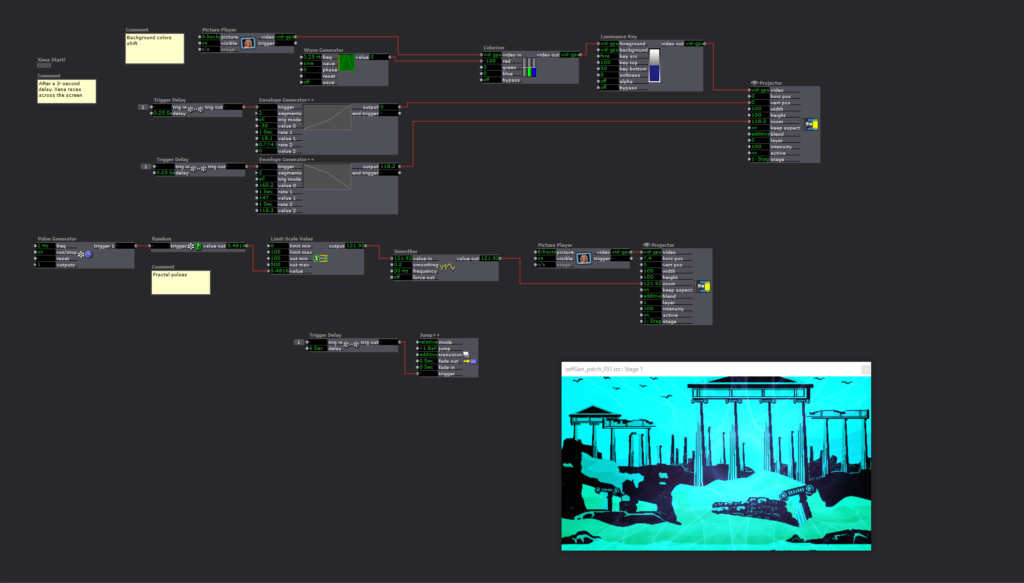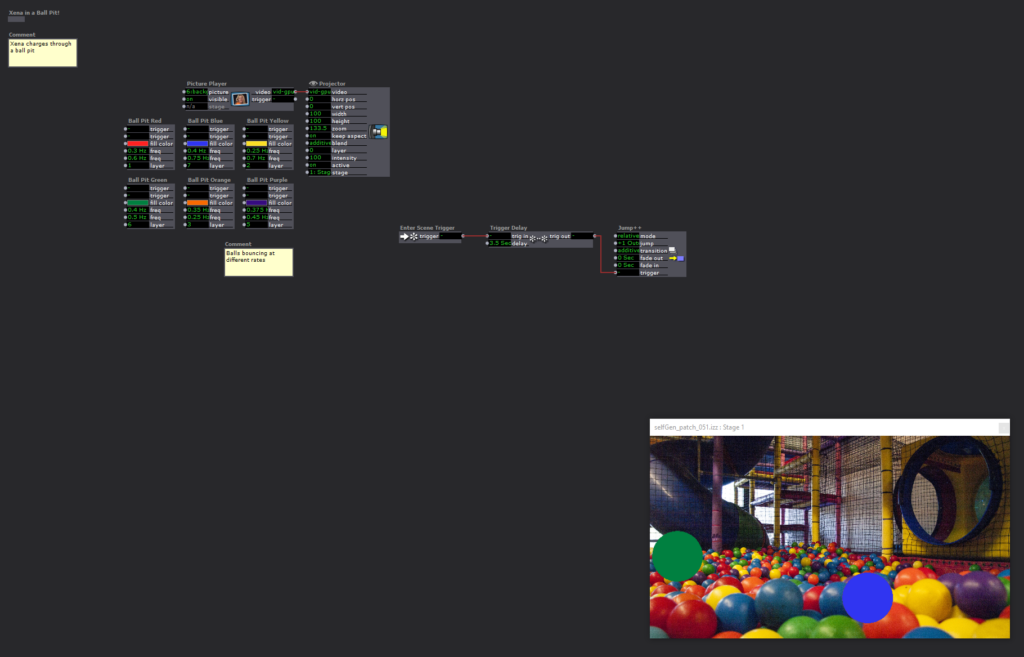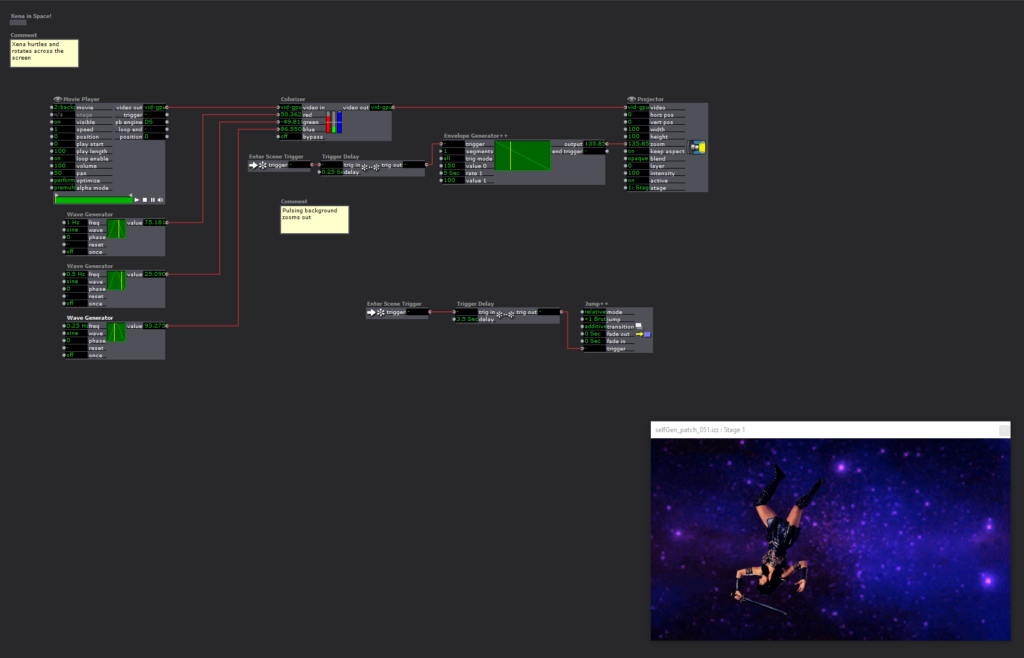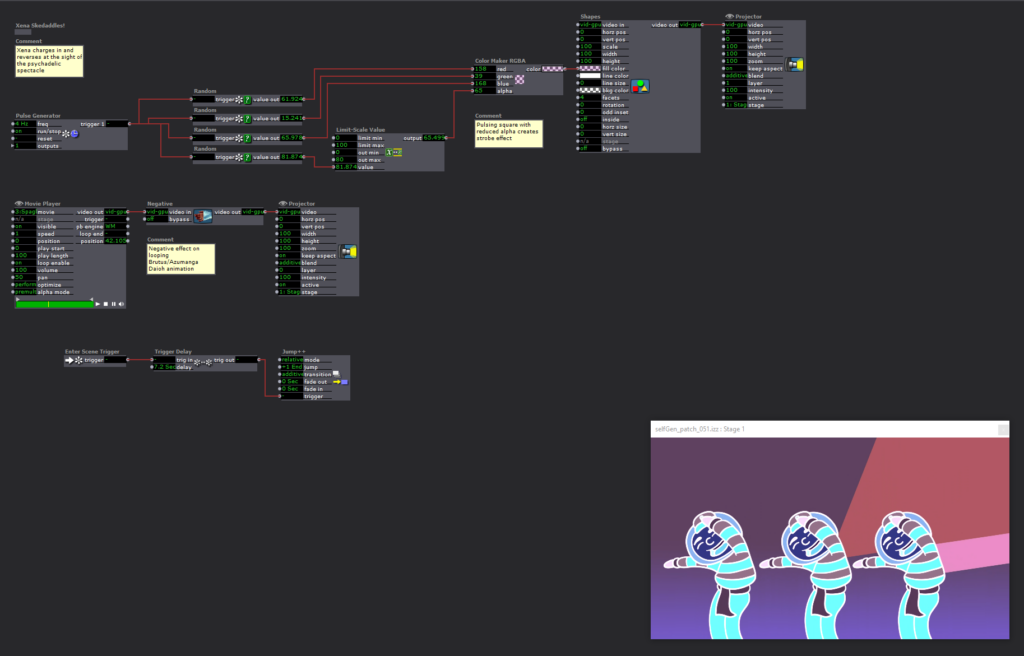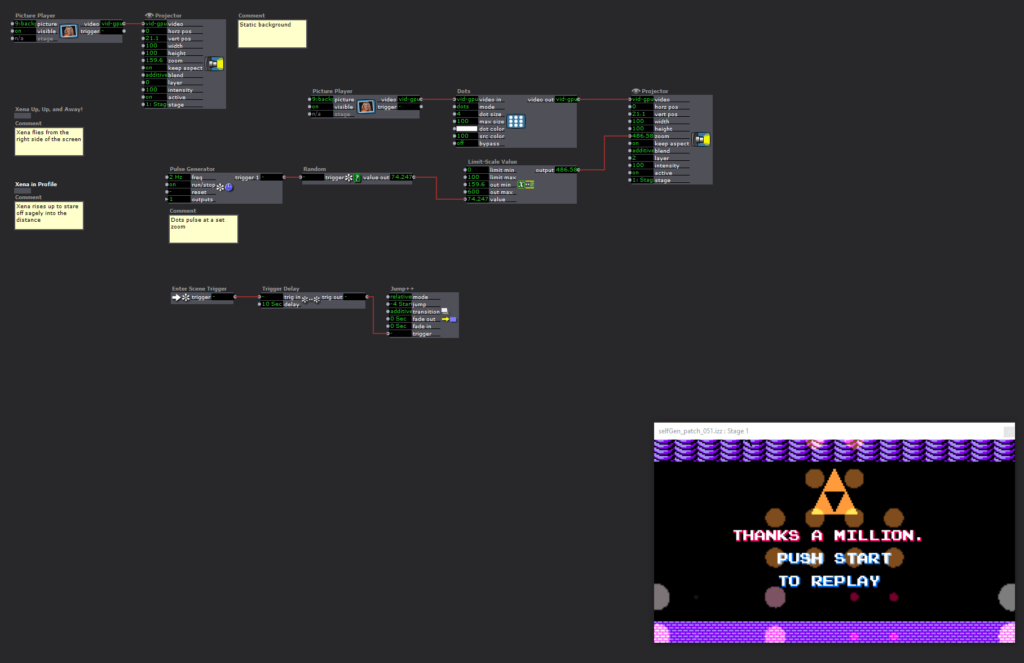Pressure Project 1 (Sara)
Posted: January 31, 2021 Filed under: Assignments, Pressure Project I, Sara C Leave a comment »The Power—The Passion—The PATCH!
Intent
I used the time-based, “pressure” parameter of this project as permission to throw spaghetti at the wall, have fun, and get weird. After all, with a hard stop of only five hours to create something that wrests the audience’s attention for as long as possible, I figured a good metric of success would be if I could make myself laugh.
This project happened to coincide with my most recent Xena Warrior Princess rewatch, so I jotted the following ideas down in my notes:
- Xena criss-crosses landscapes
- Start with patches from class tutorials and get more outlandish
- Include audio?
- Make Greece wibbly-wobbly?
After finding a PNG of Xena in profile charging with her a raised sword, I started inserting it as a user actor in multiple scenes. I thought it would be strange and delightful for her to race across non sequitur landscapes in a bizarre imitation of a side-scrolling video game.
I sought to riff on ideas introduced in class in playful ways. Imagine Xena wading through a ball pit! That’d be a good use of the toying with the Shape actor. We created weird, pulsing effects with the Wave Generator—that sort of reminds me of ping-ponging through a wormhole! My goal was to tweak and adjust and keep Xena’s quest fresh with each subsequent scene.
Difficulties
I desperately wanted to include the Xena Warrior Princess Main Title theme to score this oddball project, but I ran out of time to hammer out the specifics. I watched an Isadora sound tutorial that was fairly straightforward, but I couldn’t for the life of me get the mp3 to import into the Sound Bin; despite my flailing efforts, it kept getting stuck in the Video Bin. As such, I couldn’t follow the tutorial’s advice for setting start and stop times since it was predicated on using the Sound Player actor. Perhaps there’s a way to lay a sound bed underneath every scene, but I wasn’t certain how to do it, and I didn’t have the time to individually fiddle and tweak individual Video Player actors to get the song to flow fluidly between scenes.
Additionally, the initial vertical and horizontal positions of some images had to be repeatedly tweaked and didn’t remain consistent upon repeated plays. Maybe the issue will crop up in the class critique. If it does, I’ll gladly point it out and request help resolving the matter!
Accomplishments
My proudest accomplishment with this project is establishing automation. Once the user hits the Start button, a network of Enter Scene Triggers, Trigger Delays, and Jump Actors will bob and weave the disparate scenes and elements together, one right after the other. Once the patch finishes, it hops all the way back to the beginning, and the user can hit the Start button again. Truthfully, that small trick is what brings me the most delight.
Project Bump – Sean
Posted: January 28, 2021 Filed under: Uncategorized Leave a comment »Project Bump – Maria
Posted: January 27, 2021 Filed under: Uncategorized Leave a comment »I really enjoyed the task of creating a “fortune teller machine” for this pressure project. I have no idea how I would make it myself (although I think I could probably figure it out if I spent some time playing around), but I thought it was a really cool application of the interactivity of what Isadora allows!
Reading this student’s reflection revealed a variety of issues that I will probably run into in my own pressure projects, like spending several hours trying to find a specific actor, or making a patch much more complex than it actually needs to be. It’s good to be reminded that these are part of everyone’s learning processes and I shouldn’t let them get me down if I run into them myslef 🙂
Project Bump (Sara)
Posted: January 26, 2021 Filed under: Uncategorized Leave a comment »I scrolled backwards through time to find a project that caught my eye, but I found myself somewhat overwhelmed by the myriad techniques and technologies on display that we have not yet discussed in class. For my own peace of mind (and, admittedly, to satisfy my curiosity), I then clicked on my former peer Taylor’s subsection to scope out his very first Pressure Project in the course.
As is to be expected from one of the most cerebral people I have known, even Taylor’s first foray into Isadora was technically-challenging and highly interactive. What most struck me about the work, though, was his writing in relation to it. He speaks frankly about frustrations, fiddling, and failures even in the midst of what evolved into a successful work. And honestly, I found this to be encouraging. Yes, I will undoubtedly, most assuredly bump into any number of walls as I try to cobble something “delightful” together in five hours. But, given that hard and fast time constraint, rather than try to punch the wall down with my fists, I’ll need to circumnavigate these barriers to keep moving forward. Taylor mentioned that the time limitation led him to make “simpler choices.” I’ll keep that in mind and try to do the same.
MByrne Bump
Posted: January 26, 2021 Filed under: Uncategorized Leave a comment »https://dems.asc.ohio-state.edu/?p=2597
Here we have an interactive photo-booth design that allows the user to place themselves in a setting and costume of their choosing. I resonated with Matt’s project since I am interested in bringing XR elements into live music performance, especially with the sudden prevalence of virtual events. Infected Mushroom did a tour with XR and projection mapping at least 5 years ago, but they did a one-off virtual event more in-line with this back in November.
https://www.youtube.com/watch?v=ElFL6JswhIQ
Project Bump
Posted: January 25, 2021 Filed under: Uncategorized Leave a comment »I selected Emily Pickens’s third pressure project. The concept and execution are very simple, but I found it to be a very fun interactive object. It is a box with several touch sensitive spots on it that when touched play a different sound. It uses the makey makey and has the user keep one hand on ground while exploring the box with their other. The Isaodra setup seems quite straightforward, but I think there are so many ways one could further this idea and have different touchpoints trigger a variety of feedback. Maybe the box vibrates when you touch one area. Or flashes a color from the inside at another.
